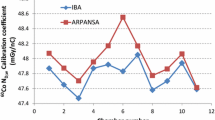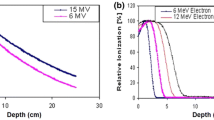Abstract
Australian primary standards of air kerma and absorbed dose are realized in60Co gamma rays. To calibrate the megavoltage photon beams from linear accelerators, radiotherapy centres have their ionization chamber calibrated in a60Co beam and then use a protocol to transfer this calibration to the higher energy. The radiotherapy community is in the process of changing from the ACPSEM Protocol (Second Edition 1998) based on an air kerma calibration to the IAEA’s TRS-398 Code of Practice, based on an absorbed dose to water calibration. To evaluate the shift in absorbed dose resulting from the new protocol, the absorbed dose should be determined using both protocols and compared. We present a formula for this shift which can be used to check the result. To use this formula the centre needs to measure a displacement correction and know the ratio of the air kerma to absorbed dose to water calibration factors at60Co. We calculate the change they should expect by using the average ratio of the air kerma and absorbed dose to water calibration factors for NE2571 and NE2561 chambers, based on Australian standards, and by estimating the displacement correction from published depth dose data. We find the absorbed dose in a megavoltage photon beam to increase by between 0.1 and 0.6% for NE2571 chambers and between 0.7 and 1.1% for NE2561 chambers, for beams up to 35 MV. The dose measured using TRS-398 is always higher.
Similar content being viewed by others
References
Australasian College of Physical Scientists and Engineers in Medicine,Absorbed dose determination in photon and electron beams: an adaptation of the IAEA international codes of practice, 2nd Edition, Australasian College of Physical Scientists and Engineers in Medicine, 1998.
International Atomic Energy Agency,Absorbed Dose Determination in Photon and Electron Beams — An International Code of Practice, 2nd Edition, IAEA Technical Reports Series No. 277, IAEA, Vienna, 1997.
International Atomic Energy Agency,The Use of Plane Parallel Ionization Chambers in High Energy Electron and Photon Beams, IAEA Technical Report Series No. 381, IAEA, Vienna, 1997.
Andreo, P., Burns, D. T., Hohlfeld, K., Huq, M. S., Kanai, T., Laitano, F., Smyth, V. and Vynckier, S.,Absorbed Dose Determination in External Beam Radiotherapy: An International Code of Practice for Dosimetry Based on Standards of Absorbed Dose to Water, IAEA Technical Report Series No. 398, IAEA, Vienna, 2000.
Andreo, P., Huq, M. S., Westermark, M., Song, H., Tilikidis, A., DeWerd, L., and Shortt, K.,Protocols for the dosimetry of high-energy photon and electron beams: a comparison of the IAEA TRS-398 and previous international Codes of Practice, Phys. Med. Biol., 47:3033–3053, 2002.
Palmans, H., Nafaa, L., De, J. J., Gillis, S., Hoornaert, M. T., Martens, C., Piessens, M., Thierens, H., Van der Plaetsen, A. and Vynckier, S.,Absorbed dose to water based dosimetry versus air kerma based dosimetry for high-energy photon beams: an experimental study, Phys. Med. Biol., 47(3):421–440, 2002.
Huq, M. S. and Andreo, P.,Advances in the determination of absorbed dose to water in clinical high-energy photon and electron beams using ionization chambers, Phys. Med. Biol., 49:R49-R104, 2004.
Huntley, R.,The use of 60 Co calibration factors in megavoltage radiotherapy dosimetry, 1st Edition, Australian Radiation Protection and Nuclear Safety Agency Fact Sheet, August 2001, http://www.arpansa.gov.au/cobalt.htm
Jordan, T. J.,Megavoltage X-ray Beams: 2–50 MV, Br. J. Radiol., Suppl. 25, pp 62–109, 1996.
Johansson, K. A., Mattsson, L.O., Lindborg, L., and Svensson, H.,Absorbed dose determination with ionization chambers in electron and photon beams having energies between 1 and 50 MeV, Proceedings National and International Standardization of Radiation Dosimetry, 2, IAEA Vienna, pp 243–270, 1978.
Shortt, K., Shobe, J. and Domen, S.,Comparison of dosimetry calibration factors at the NRCC and the NIST, Med. Phys., 27:1644–1654, 2000.
Palmans, H., Nafaa, L., de Patoul, N., Denis, J-.M., Tomsej, M. and Vynckier, S.,A dosimetry study comparing NCS report-5, IAEA TRS-381, AAPM TG-51 and IAEA TRS-398 in three clinical electron beam energies, Phys. Med. Biol., 48:1091–1107, 2003.
Author information
Authors and Affiliations
Corresponding author
Rights and permissions
About this article
Cite this article
Butler, D.J., Palmans, H. & Webb, D.V. Shift in absorbed dose for megavoltage photons when changing to TRS-398 in Australia. Australas. Phys. Eng. Sci. Med. 28, 159 (2005). https://doi.org/10.1007/BF03178709
Received:
Accepted:
DOI: https://doi.org/10.1007/BF03178709




